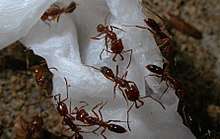Anochetus ghilianii
Anochetus ghilianii is a species of ant of the subfamily Ponerinae, which is native to Morocco, and it also has a not confirmed status in Gibraltar and Spain, as scientists are not sure whether its native or exotic due having a very low area where it lives in the Iberian peninsula (Only found in the province of Cadiz in Spain).[1]
| Anochetus ghilianii | |
|---|---|
 | |
| Scientific classification | |
| Kingdom: | |
| Phylum: | |
| Class: | |
| Order: | |
| Suborder: | |
| Family: | |
| Subfamily: | |
| Genus: | |
| Species: | A. ghilianii |
| Binomial name | |
| Anochetus ghilianii (Spinola, 1851) | |
The species is monogynous, the queens of this species is ergatoid, meaning that it does not have wings. However the males from the colony do have wings. The worker ammount can variate from having between 300-250 in early months of the year to just between 10-50 in the summer, thus the colonies are not very big and they are usually 20-30cm deep.
How to identify
This species is very easy to identify from other species as there arent other Ponerinae trap jaw ants species in Morocco and the Iberian Peninsula and the other trap jaw ants in these countries are from the Strumigenys genus and have triangle heads instead of hexagonal heads. These things mean that it is imposible to confuse it for another species from those countries.
Defense and attack
Just like other Anochetus and Odontomachus species this species has both a stinger and its iconic mandibles which they use to defend them selfs and get pray. The stinger is used to inject a toxin that paralises its pray. The mandibles can be both used to bite and snap it against something to propel them selfs backwards for a quick escape.
References
- "Antmaps A.Ghilianii". Antmaps.
External links
- "Anochetus Ghilianii" - AntWeb
- "Anochetus Ghilianii"- AntWiki
- "Animaldiversity.org"
- "Itis.org"